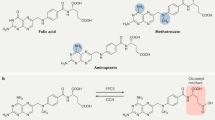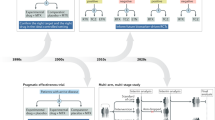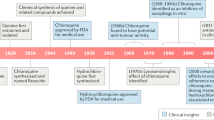Abstract
The chronic nature of rheumatoid arthritis (RA) means that patients require drug therapy for many years. Many RA patients, however, have to discontinue treatment because of drug-related toxic effects, loss of efficacy, or both. The underlying molecular cause for loss of efficacy of antirheumatic drugs is not fully understood, but it might be mediated, at least in part, by mechanisms shared with resistance to anticancer drugs. This Review outlines molecular mechanisms that could be involved in the onset of resistance to, or the loss of efficacy of, disease-modifying antirheumatic drugs in RA patients, including methotrexate, sulfasalazine, chloroquine, hydroxychloroquine, azathioprine, and leflunomide. The mechanisms suggested are based on findings from experimental laboratory studies of specific drug-uptake and drug-efflux transporters belonging to the superfamily of multidrug-resistance transporters, alterations in intracellular drug metabolism, and genetic polymorphisms of drug transporters and metabolic enzymes. We also discuss strategies to overcome resistance and the current clinical studies aiming to predict response and risk of toxic effects. More in-depth knowledge of the mechanisms behind these features could help facilitate a more efficient use of disease-modifying antirheumatic drugs.
Key Points
-
Disease-modifying antirheumatic drugs (DMARDs) and anticancer drugs share common molecular mechanisms of resistance
-
Resistance to DMARDs can be acquired by upregulation of drug-efflux proteins belonging to the family of multidrug-resistance transporters
-
Multidrug-resistance proteins exert primary physiologic functions in the cellular export of inflammatory mediators
-
The current knowledge of molecular mechanisms of resistance to methotrexate facilitates the prediction of patient response to methotrexate by target-directed genetic and biochemical screening of blood cells
-
Identification of the molecular mechanisms of resistance to various DMARDs opens up new strategies for circumvention of drug resistance
This is a preview of subscription content, access via your institution
Access options
Subscribe to this journal
Receive 12 print issues and online access
$209.00 per year
only $17.42 per issue
Buy this article
- Purchase on Springer Link
- Instant access to full article PDF
Prices may be subject to local taxes which are calculated during checkout

Similar content being viewed by others
References
Smolen JS and Steiner G (2003) Therapeutic strategies for rheumatoid arthritis. Nat Rev Drug Discov 2: 473–488
O'Dell JR (2004) Therapeutic strategies for rheumatoid arthritis. N Engl J Med 350: 2591–2602
Goekoop-Ruiterman YP et al. (2005) Clinical and radiographic outcomes of four different treatment strategies in patients with early rheumatoid arthritis (the BeSt study): a randomized, controlled trial. Arthritis Rheum 52: 3381–3390
Szakacs G et al. (2006) Targeting multidrug resistance in cancer. Nat Rev Drug Discov 5: 219–234
Jansen G et al. (2003) Multidrug resistance proteins in rheumatoid arthritis, role in disease-modifying antirheumatic drug efficacy and inflammatory processes: an overview. Scand J Rheumatol 32: 325–336
Wollheim FA (2003) Drug resistance in rheumatology: an area in search of investigators. Curr Rheumatol Rep 5: 333–335
Fleischmann RM (2005) Is there a need for new therapies for rheumatoid arthritis? J Rheumatol 73 (Suppl): S3–S7
Choy EH et al. (2005) A meta-analysis of the efficacy and toxicity of combining disease-modifying anti-rheumatic drugs in rheumatoid arthritis based on patient withdrawal. Rheumatology (Oxford) 44: 1414–1421
Nurmohamed MT and Dijkmans BA (2005) Efficacy, tolerability and cost effectiveness of disease-modifying antirheumatic drugs and biologic agents in rheumatoid arthritis. Drugs 65: 661–694
Aletaha D and Smolen JS (2002) Effectiveness profiles and dose dependent retention of traditional disease modifying antirheumatic drugs for rheumatoid arthritis. An observational study. J Rheumatol 29: 1631–1638
Bingham S and Emery P (2000) Resistant rheumatoid arthritis clinics—a necessary development? Rheumatology (Oxford) 39: 2–5
Wolfe F (1995) The epidemiology of drug treatment failure in rheumatoid arthritis. Baillieres Clin Rheumatol 9: 619–632
Morgan C et al. (2003) Contribution of patient related differences to multidrug resistance in rheumatoid arthritis. Ann Rheum Dis 62: 15–19
Delano DL et al. (2005) Genetically based resistance to the antiinflammatory effects of methotrexate in the air-pouch model of acute inflammation. Arthritis Rheum 52: 2567–2575
Zaher H et al. (2006) Breast cancer resistance protein (Bcrp/abcg2) is a major determinant of sulfasalazine absorption and elimination in mouse. Mol Pharm 3: 55–61
Borst P and Elferink RO (2002) Mammalian ABC transporters in health and disease. Annu Rev Biochem 71: 537–592
Gorlick R et al. (1996) Intrinsic and acquired resistance to methotrexate in acute leukemia. N Engl J Med 335: 1041–1048
Rots MG et al. (2000) Classification of ex vivo methotrexate resistance in acute lymphoblastic and myeloid leukaemia. Br J Haematol 110: 791–800
Matherly LH and Goldman ID (2003) Membrane transport of folates. Vitam Horm 66: 403–456
Nakashima-Matsushita N et al. (1999) Selective expression of folate receptor beta and its possible role in methotrexate transport in synovial macrophages from patients with rheumatoid arthritis. Arthritis Rheum 42: 1609–1616
Hooijberg JH et al. (1999) Antifolate resistance mediated by the multidrug resistance proteins MRP1 and MRP2. Cancer Res 59: 2532–2535
Shafran A et al. (2005) ABCG2 harboring the Gly482 mutation confers high-level resistance to various hydrophilic antifolates. Cancer Res 65: 8414–8422
Van der Heijden J et al. (2004) Acquired resistance of human T cells to sulphasalazine: stability of the resistant phenotype and sensitivity to non-related DMARDs. Ann Rheum Dis 63: 131–137
Van der Heijden J et al. (2004) Development of sulphasalazine resistance in human T cells induces expression of the multidrug resistance transporter ABCG2 (BCRP) and augmented production of TNFalpha. Ann Rheum Dis 63: 138–143
Oerlemans R et al. (2006) Acquired resistance to chloroquine in human CEM T cells is mediated by multidrug resistance-associated protein 1 and provokes high levels of cross-resistance to glucocorticoids. Arthritis Rheum 54: 557–568
Glennas A and Rugstad HE (1986) Cultured human cells with high levels of gold-binding cytosolic metallothionein are not resistant to the growth inhibitory effect of sodium aurothiomalate. Ann Rheum Dis 45: 101–109
Clunie GP and Lennard L (2004) Relevance of thiopurine methyltransferase status in rheumatology patients receiving azathioprine. Rheumatology (Oxford) 43: 13–18
Wielinga PR et al. (2002) Thiopurine metabolism and identification of the thiopurine metabolites transported by MRP4 and MRP5 overexpressed in human embryonic kidney cells. Mol Pharmacol 62: 1321–1331
Loffler M et al. (2004) Dihydroorotate dehydrogenase mRNA and protein expression analysis in normal and drug-resistant cells. Nucleosides Nucleotides Nucleic Acids 23: 1281–1285
Chikanza IC and Kozaci DL (2004) Corticosteroid resistance in rheumatoid arthritis: molecular and cellular perspectives. Rheumatology 43: 1337–1345
Buttgereit F et al. (2004) Glucocorticoids in the treatment of rheumatic diseases: an update on the mechanisms of action. Arthritis Rheum 50: 3408–3417
Maetzel A et al. (2000) Meta-analysis of treatment termination rates among rheumatoid arthritis patients receiving disease-modifying anti-rheumatic drugs. Rheumatology (Oxford) 39: 975–981
Galindo-Rodriguez G et al. (1999) Disappointing longterm results with disease modifying antirheumatic drugs. A practice based study. J Rheumatol 26: 2337–2343
Salmon SE and Dalton WS (1996) Relevance of multidrug resistance to rheumatoid arthritis: development of a new therapeutic hypothesis. J Rheumatol 44 (Suppl): S97–S101
Maillefert JF et al. (1996) Expression of the multidrug resistance glycoprotein 170 in the peripheral blood lymphocytes of rheumatoid arthritis patients. The percentage of lymphocytes expressing glycoprotein 170 is increased in patients treated with prednisolone. Br J Rheumatol 35: 430–435
Llorente L et al. (2000) Multidrug resistance-1 (MDR-1) in rheumatic autoimmune disorders. Part I: increased P-glycoprotein activity in lymphocytes from rheumatoid arthritis patients might influence disease outcome. Joint Bone Spine 67: 30–39
Yudoh K et al. (1999) Increased expression of multidrug resistance of glycoprotein on Th1 cells correlates with drug resistance in rheumatoid arthritis. Arthritis Rheum 42: 2014–2015
Rahman P et al. (2000) Increased MDR1 P-glycoprotein expression in methotrexate resistance: comment on the article by Yudoh et al. Arthritis Rheum 43: 1661–1662
Norris MD et al. (1996) Involvement of MDR1 P-glycoprotein in multifactorial resistance to methotrexate. Int J Cancer 65: 613–619
Oerlemans R et al. (2005) Differential expression of multidrug resistance-related proteins on monocyte-derived macrophages from rheumatoid arthritis patients. Arthritis Res Ther 7 (Suppl 1): P83
Van der Heijden JW et al. (2005) Expression of the multidrug resistance protein BCRP in synovial tissue of RA patients—a marker for inflammation or resistance to MTX? Arthritis Rheum 52 (Suppl): S540
Scotto KW (2003) Transcriptional regulation of ABC drug transporters. Oncogene 22: 7496–7511
Hider SL et al. (2006) Down-regulation of MRP1 expression in early RA patients exposed to methotrexate as a first DMARD. Ann Rheum Dis 65: 1449–1455
Stranzl T et al. (2003) Expression of folylpolyglutamyl synthetase predicts poor response to methotrexate therapy in patients with rheumatoid arthritis. Clin Exp Rheumatol 21: 27–32
Wolf J et al. (2005) Expression of resistance markers to methotrexate predicts clinical improvement in patients with rheumatoid arthritis. Ann Rheum Dis 64: 564–568
Ranganathan P et al. (2003) Will pharmacogenetics allow better prediction of methotrexate toxicity and efficacy in patients with rheumatoid arthritis? Ann Rheum Dis 62: 4–9
Dervieux T et al. (2004) Polyglutamation of methotrexate with common polymorphisms in reduced folate carrier, aminoimidazole carboxamide ribonucleotide transformylase, and thymidylate synthase are associated with methotrexate effects in rheumatoid arthritis. Arthritis Rheum 50: 2766–2774
Dervieux T et al. (2004) Contribution of common polymorphisms in reduced folate carrier and gamma-glutamylhydrolase to methotrexate polyglutamate levels in patients with rheumatoid arthritis. Pharmacogenetics 14: 733–739
Weisman MH et al. (2006) Risk genotypes in folate-dependent enzymes and their association with methotrexate-related side effects in rheumatoid arthritis. Arthritis Rheum 54: 607–612
Wessels JA et al. (2006) Efficacy and toxicity of methotrexate in early rheumatoid arthritis are associated with single-nucleotide polymorphisms in genes coding for folate pathway enzymes. Arthritis Rheum 54: 1087–1095
Kremer JM (2004) Toward a better understanding of methotrexate. Arthritis Rheum 50: 1370–1382
Smolen JS et al. (2005) Superior efficacy of combination therapy for rheumatoid arthritis: fact or fiction? Arthritis Rheum 52: 2975–2983
Jansen G et al. (2004) Sulfasalazine is a potent inhibitor of the reduced folate carrier: implications for combination therapies with methotrexate in rheumatoid arthritis. Arthritis Rheum 50: 2130–2139
O'Dell JR et al. (2002) Treatment of rheumatoid arthritis with methotrexate and hydroxychloroquine, methotrexate and sulfasalazine, or a combination of the three medications. Arthritis Rheum 46: 1164–1170
Goekoop-Ruiterman YP et al. (2005) Clinical and radiographic outcomes of four different treatment strategies in patients with early rheumatoid arthritis (the BeSt study): a randomized, controlled trial. Arthritis Rheum 52: 3381–3390
Rots MG et al. (1999) Circumvention of methotrexate resistance in childhood leukemia subtypes by rationally designed antifolates. Blood 94: 3121–3128
Wolbink GJ et al. (2006) Development of antiinfliximab antibodies and relationship to clinical response in patients with rheumatoid arthritis. Arthritis Rheum 54: 711–715
Cronstein BN (1996) Molecular therapeutics. Methotrexate and its mechanism of action. Arthritis Rheum 39: 1951–1960
Cutolo M et al. (2001) Anti-inflammatory mechanisms of methotrexate in rheumatoid arthritis. Ann Rheum Dis 60: 729–735
Acknowledgements
Work described in this Review was supported by grants from the Dutch Arthritis Association and The Netherlands Organization for Scientific Research. JW van der Heijden is a recipient of the 2006 Rheumatology Grant from the Dutch Association for Rheumatology. We apologize to authors whose work could not be cited for space reasons.
Author information
Authors and Affiliations
Corresponding author
Ethics declarations
Competing interests
The authors declare no competing financial interests.
Rights and permissions
About this article
Cite this article
van der Heijden, J., Dijkmans, B., Scheper, R. et al. Drug Insight: resistance to methotrexate and other disease-modifying antirheumatic drugs—from bench to bedside. Nat Rev Rheumatol 3, 26–34 (2007). https://doi.org/10.1038/ncprheum0380
Received:
Accepted:
Issue Date:
DOI: https://doi.org/10.1038/ncprheum0380
This article is cited by
-
Methotrexate conjugated gold nanoparticles improve rheumatoid vascular dysfunction in rat adjuvant-induced arthritis: gold revival
Inflammopharmacology (2023)
-
Network analysis of synovial RNA sequencing identifies gene-gene interactions predictive of response in rheumatoid arthritis
Arthritis Research & Therapy (2022)
-
Distinct metabolic biomarkers to distinguish IgG4-related disease from Sjogren’s syndrome and pancreatic cancer and predict disease prognosis
BMC Medicine (2022)
-
A multi-omics analysis reveals the unfolded protein response regulon and stress-induced resistance to folate-based antimetabolites
Nature Communications (2020)
-
Apoptotic cell infusion treats ongoing collagen-induced arthritis, even in the presence of methotrexate, and is synergic with anti-TNF therapy
Arthritis Research & Therapy (2016)



